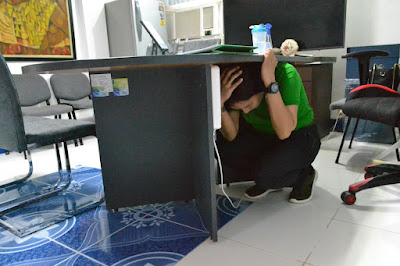PHIVOLCS shares tips on how to deal with aftershocks
By Renelle L. Escuadro
The
Philippine Institute of Volcanology and Seismology (PHIVOLCS) recorded over
6,000 aftershocks after the magnitude 7.4 and 6.8 earthquakes that jolted
the province of Surigao del Sur on December 2 and 4.
With this, PHIVOLCS reminded the public to remember the following significant tips to deal with aftershocks, as these series of tremors continue to pose potential risks to one’s life and safety.
Duck, cover, and hold
According to PHIVOLCS Director Teresito Bacolcol during the Infosentro sa PHIVOLCS on December 3, “After a large quake, aftershocks happen from weeks to even months, however, on a lesser magnitude.”
“It was magnitude 7.4 in Hinatuan town as the epicenter of the recent quake; aftershocks range somewhere in magnitude 6.4. which are still strong that is why we have to be prepared and ready,” added Dir. Bacolcol.
With this, it is still best for everyone to be vigilant and committed to protecting ourselves through the proper execution of the duck, cover, and hold even during aftershocks: When there’s an earthquake, duck to the floor; cover your head and neck under a sturdy table or desk. If there is no shelter nearby, cover your head and neck with your arms and hands; and hold on to your shelter or your position to protect your head and neck until the shaking stops.
Check for damages
After the tremor, inspect your house during the day for possible cracks, damaged masonry, and electrical wiring, among others. It is also advisable to immediately notify proper authorities for an assessment.
Dir. Bacolcol also reminded everyone that strong aftershocks can compromise building integrity, and we should not be complacent.
“Lalo na sa malapit sa epicenter, if may nakita kayong crack sa bahay, ipa check niyo na agad. Kasi if hindi ito nasira sa main shock, baka masira ito sa malakas na aftershock [Especially those living near the epicenter, if you notice a crack in your house, have this checked immediately because if not by the main shock, a strong aftershock might destroy your house],“ explained Bacolcol.
Emergency kit, anytime, anywhere
Since aftershocks are unpredictable and their duration is immeasurable, place an emergency kit in strategic and accessible areas in your house, at work, and in the car.
Bring always a handy emergency kit. In this manner, your emergency kit is always ready and you don’t have to panic in case there is an injury during an aftershock.
Emergency kits may contain dressings and bandages, alcohol, over-the-counter medicine for cuts and injuries, a small whistle, and a flashlight.
The Pacific trench was the generator of the recent earthquakes in Surigao del Sur, as the country has five active trenches and about 30 fault systems where earthquakes may develop. Hence, the government continues to equip and instill the importance of readiness to everyone. (RLE/PIA-Caraga)


